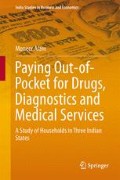Abstract
The preceding three chapters have lent considerable evidence to suggest that people in backward regions of UP and Rajasthan are severely pressured by OOP expenditure on health care. Almost a similar result was presented for the slum residents in Delhi as well. These results have also lent credence to the fact that a bulk of these households is marred by varying levels of catastrophe with possibilities of major curtailments in their living conditions. A probit regression analysis in Chap. 5 further indicates that the poor, economically less secured, lower caste, moderately educated, poor sanitation, lack of access to potable drinking water, low levels of living without proper lighting or cooking fuel and kutcha houses are among the factors making people susceptible to enhanced risks of health catastrophe. However, a question that needs to be examined in the context of these findings is: what happens to the public health facilities and despite high financial burden, why do people go to private practitioners? A related question may arise with regard to the utilisation of added services created in rural areas since the inception of the NRHM in April 2005. Do people even know about these facilities and their intended objectives to provide an added package of services including sanitation, potable drinking water, better childcare with timely vaccination and assistance to pregnant rural women with basic medicines and institutional deliveries? We will try to examine a few, if not all, of these issues in the rest of this chapter.
Access this chapter
Tax calculation will be finalised at checkout
Purchases are for personal use only
Notes
- 1.
Primary health-care facilities created over the years by the government in rural areas have evolved on the basis of certain population norms. These include subcentres for every 3,000–5,000 population, primary health centres (PHCs) for a total of 20,000–30,000 population and community health centres (CHC) for 80,000–120,000 population. Lower population norms have been used for the tribal and hilly areas (Ministry of Health & Family Welfare, Government of India 2006). Most of these services have however been driven to a considerable extent by the family planning objectives of the government.
- 2.
It ought to be mentioned that the debate on disassociating factors making people indifferent towards the public health facilities is decades old. There have been several studies directed to this issue in the past (see, e.g. Bose and Tyagi 1983: 104–122). What is however interesting is that the inferences drawn in those earlier studies match closely with our own. In other words, the public sector, despite major attempts, has not been able to shed many of its past limitations.
- 3.
In addition to subjectivity, it must also be confessed that the survey designed to undertake this study and most of its questions were not framed with the NRHM as the central issue. Hence, a further and more in-depth analysis of the issues raised here would require a separate study and database.
References
Bose, A., & Tyagi, R. P. (1983). Rural health services: Present status. In A. Bose & P. B. Desai (Eds.), Studies in social dynamics of primary health care (pp. 104–122). Delhi: Hindustan Publishing Corporation (India).
Kumar, A. K. S. (2005, April 2). Budgeting for health: Some considerations. Economic and Political Weekly, 1391–1396.
MoHFW (Government of India). (2006). Family welfare statistic in India – 2006 (p. 33).
Planning Commission, Government of India. (2008). Eleventh Five Plan (2007–2012), social sector (Vol. II, p. 58). New Delhi: Oxford University Press.
Shear, S. (2008, September13). The national rural health mission – A stocktaking. Economic and Political Weekly, 23–26.
Sinha, A. (2009). In defence of the rural health mission. Economic and Political Weekly, 72–75.
Author information
Authors and Affiliations
Rights and permissions
Copyright information
© 2013 Springer India
About this chapter
Cite this chapter
Alam, M. (2013). Utilisation of Public Health Facilities: A Situational Assessment. In: Paying Out-of-Pocket for Drugs, Diagnostics and Medical Services. India Studies in Business and Economics. Springer, New Delhi. https://doi.org/10.1007/978-81-322-1281-2_7
Download citation
DOI: https://doi.org/10.1007/978-81-322-1281-2_7
Published:
Publisher Name: Springer, New Delhi
Print ISBN: 978-81-322-1280-5
Online ISBN: 978-81-322-1281-2
eBook Packages: Business and EconomicsEconomics and Finance (R0)

